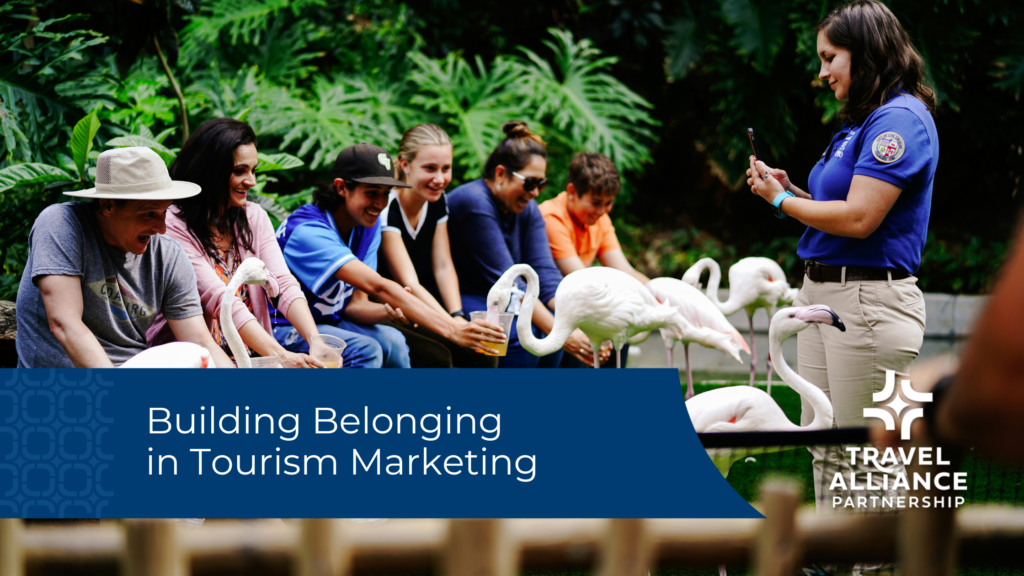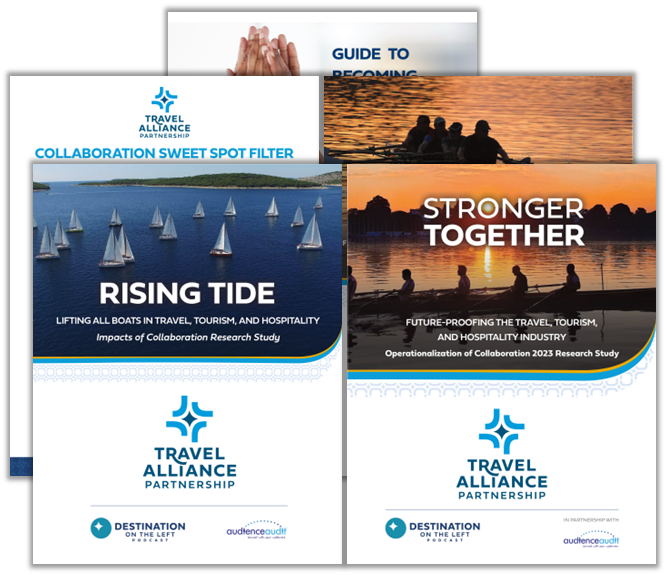Building Belonging in Tourism Marketing
The days of relying on glossy brochures and catchy taglines to attract travelers are behind us. Today, what truly resonates with visitors isn’t a brand’s flashy exterior, but a deeper, emotional connection that they have with the brand’s product, experience, mission, or personality.

Mark Schaefer’s book Belonging to the Brand sheds light on the power of fostering community, and its lessons are particularly impactful for the tourism industry. Society has been experiencing a loneliness crisis, which was only intensified by the global pandemic, making people long to feel included. By creating spaces where guests and travelers belong, destinations and tourism organizations can deliver emotional fulfillment that establishes long-term loyalty, advocacy, and genuine connections with their audiences.
Our team dove into Schaefer’s book late last year and we were inspired by his perspective on building and sustaining communities. Below, we’ll explore how destinations can apply some of these insights to build their own sense of belonging.
What is a Community?
First, let’s define “community.” This is not just a follower on social media or a subscriber to your content. It is the ultimate customer connection. According to Schaefer, it “represents the uppermost level of emotional alignment and commitment”. The strongest communities are self-sustaining, have meaningful conversations, share mutual appreciation, and even “become the business”.
Communities can exist online and offline – such as an in-person group, annual meetup, local ambassador network, mobile app audience, or social media forum – and will continue to expand with emerging technologies like metaverse and tokenized economies. All communities have three features:
- Connection to each other
- Purpose for gathering
- Relevance to the needs of its members
Why Belonging Matters in Tourism
Travel is an emotional, immersive experience. At its core, it’s about connection – to new places, people, environments, and, often, ourselves. When destinations nurture a sense of belonging, they tap into this emotional essence of travel. It’s no longer just about visiting a location; it’s about being part of a shared story, culture, or purpose. This belonging keeps visitors coming back and inspires them to share their experiences with others, creating organic growth through advocacy.
An example of this comes from New Zealand’s Tiaki Promise campaign. This initiative encourages travelers to act as guardians of the land, respecting and protecting the environment. By adopting the values of the local community, visitors feel part of something greater than themselves. They’re no longer just tourists; they’re stewards of New Zealand.
Another example is the “Screech In” ceremony that travelers can join in Newfoundland, Canada. This popular ritual involves learning some phrases from the unique local dialect, kissing a cod fish, and taking a shot of local screech rum, before receiving a certificate as an honorary Newfoundlander.
Destinations as the Heart of Community Building
Destinations have a unique opportunity to cultivate communities around shared identity, values, and experiences:
Define Your Community’s Purpose
What ties your destination to its visitors beyond just geography? For example, The Wild Center in the Adirondacks has created a world-wide network of young people looking to act on climate change.
Create Shared Spaces
Invite travelers to partake in cultural traditions. This may mean creating tours or intimate experiences that give travelers a firsthand look into a culture that they would not otherwise have the chance to interact with.
Leverage Digital Platforms
Online communities, such as Facebook groups or Instagram hashtags, bring visitors together pre- and post-trip. Encourage storytelling by asking fans to share their travel experiences, insider tips, or favorite photos.
Our work with Akwesasne Travel helped the Saint Regis Mohawk Tribe create a brand and experience that would immerse travelers in the experience of their territory and people. Their cultural tours invite visitors to partake in basket weaving, traditional lacrosse stick making, beading, plant medicines, and other experience unique to the area and the residents who call the land home.
The Role of Tour Operators in Fostering Belonging
Tour operators act as guides—not just physically, but emotionally. They’re the connectors who bridge the gap between the local culture and travelers. Schaefer’s work emphasizes the need for communities to have clear leaders who nurture the sense of belonging, and tour operators are perfectly positioned to fill this role through:
Personal Storytelling
Share stories of the people behind the tours and the lives they touch. Travelers will feel connected to these stories and, in turn, to the local community.
Deep Connections
Offer small group experiences that encourage bonding among the participants. Whether it’s a sunrise hike or an artisanal cooking class, these intimate moments often form the foundation of enduring friendships.
Co-Creation
Allow guests to take ownership of parts of the experience. For example, a walking tour could end with visitors contributing their favorite finds on a local map, creating a legacy that future participants can explore.
Some of TAP’s Tour Operator Partners accompany their group tours on adventures around the world. Through these excursions and shared experiences, they build great rapport with clients who become repeat customers and brand advocates.
Real-World Applications
How can your organization stand out as a community builder? Here’s how to utilize Schaefer’s principles in hands-on strategies tailored for tourism marketing:
- Virtual Communities: Create year-round engagement by hosting virtual events or online hubs where past and future visitors can connect. Think virtual wine-tasting for followers of a Wine Trail or live streams of unique cultural festivals.
- Membership Programs: Encourage repeat tourism by offering membership programs that create a sense of exclusivity and belonging. For instance, snow sports destinations could offer a community-focused ski network with perks like behind-the-scenes weather insights, connection to locals, discounts at favorite spots, and meet-ups on the slopes.
- Give Visitors a Mission: People feel belonging when they’re contributing to something bigger than themselves. Integrate volunteer tourism programs, like waterway clean-ups or wildlife preservation efforts. These initiatives build strong ties between visitors and your destination. (Check out SLELO PRISM’s Pledge-to-Protect Initiative for a great example of this!)
- Content that Drives Connection: Put faces and stories at the forefront of your marketing. Share profiles of local artisans, chefs, or guides and invite tourists to get to know the people who make your destination special. Content that celebrates shared stories helps create emotional attachment.
- Ambassador Programs: Identify individuals with a deep connection or investment to your brand and empower them to share the word with their network. Leverage their excitement to welcome others into the destination, and ultimately, the community.
- Connecting Media Beyond a Press Trip: Travel can be a transformative experience, leaving one with a deep bond to the destination and fellow travelers. Help foster that connection among media members beyond a press trip or group FAM by creating a text chat, online forum, email newsletter or annual meet-up.
Challenges and How to Overcome Them
Admittedly, building a sense of belonging isn’t without its challenges. Language and cultural barriers may hinder communication, digital fatigue can saturate online efforts, and some travelers may only seek surface-level tourism.
The key? Be intentional. Start small with clear goals. Focus on quality over quantity in building your community. It’s better to have 100 deeply engaged advocates than 10,000 passive Instagram followers. Work through barriers by leaning on local representatives, creating rich in-person experiences, and remaining consistent in your messaging.
Belonging is more than a marketing strategy; it’s a movement. By aligning your destination’s values with those of travelers and nurturing a space where they can connect meaningfully, you’ll foster a passionate community that sees your destination not as a one-time holiday but as a second home.
Author
Related Posts
Marketing for Group Travel: Building Solid Relationships with Tour Operators
Group travel is a significant segment of the tourism market, and if you want to see those buses pulling up to the curb and filling…
From Assistant to Amplifier: Rethinking AI for Tourism Marketers
After attending MAICON, a Marketing AI conference hosted by SmarterX, one message came through loud and clear: AI isn’t replacing marketers—it’s making our work sharper,…
